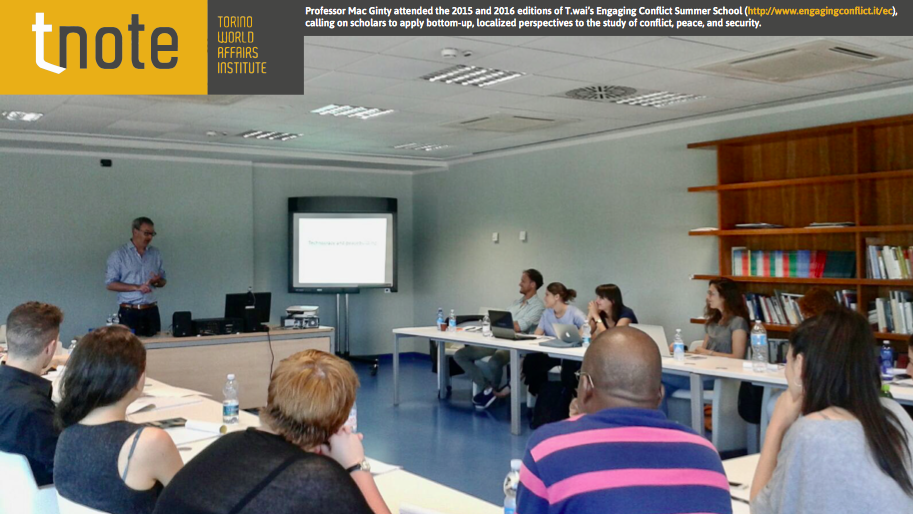
Governments, international organisations, INGOs and academics have many ways of gauging war and peace. Many of these ways use official and public systems of gathering information, such as relying on statistics gathered by national governments. Or they may rely on proxies indicators of peace or war. For example, they might regard statistics on maternal health or the number of citizens in prison as an indicator of the likelihood of peace or war.
Many of these statistics are gathered from the top-down, and amount to what James C. Scott called ‘the public transcript’. But what about ‘the hidden transcript’? How can we find out what people actually think? In societies that are fragile and may suffer from political tension and the threat of violence, people may not want to give their honest opinion on highly political matters like peace and insecurity.
Inspired by literature from ecology and critical geography, we set out to pilot a way of finding out what people in local communities actually think about these sensitive issues. The key – and what set our approach apart from many existing approaches – was that we asked people to identify their own indicators of peace, security and change. So rather than dreaming up indicators in a university seminar room, or taking off-the-shelf indicators used by the World Bank or others, we asked people what was important to them. The results were very different from orthodox stories of war, peace and insecurity.
The Everyday Peace Indicators project, funded by the Carnegie Corporation of New York, operates in three localities each in three post-conflict societies: South Africa, Uganda and Zimbabwe. It has recently started a pilot in Colombia. The project works with local research teams and uses local languages. It begins with focus groups to find out what peace and security means to people in their everyday lives, and turns the issues mentioned into a list of indicators. These community-sourced indicators are then turned into a survey that is extended throughout a locality, and repeated over time to see if there is change
Empowered to use their own vernacular to describe what peace and security meant to them, people tended to relate these important issues to their own everyday lives. Thus, for example, the barking of dogs was mentioned as a key indicator of insecurity. If the dogs barked at night, it meant that there were prowlers in the vicinity. Another indicator of peace and insecurity that people mentioned was having to urinate indoors at night. Many people used outdoor latrines to go to the bathroom. But if they felt unsafe, then they would have to urinate indoors.
These highly localised – and often highly personal indicators – reflected the everyday concerns of people. No one mentioned terms like ‘resilience’, ‘ontological security’, ‘local stakeholders’, or ‘humanitarian space’ – terms that might be common in policy or academic documents but seem removed from everyday life. Why is it important to include local and non-standard perspective sin our studies of peace and conflict? One reason is that standard, top-down and state-centric lenses often miss out a lot of detail that is highly localised. Conflict and peace is experienced locally – in the home, village, neighbourhood, and workplace. These are the frontlines of peace, reconciliation and toleration; so it makes sense that we try to understand them in their own right. Such perspectives can augment the perspectives that International Relations and many other state-centric disciplines can give us. These bottom-up and localised perspectives can add nuance and granularity to perspectives that often flatten out detail and the local. A bottom-up perspective can be seen as part of a wide attempt to re-balance epistemologies and world views so that we are more holistic and able to take account of the social, cultural and everyday spheres.
Finding out what people actually think is not easy, but it can be done. The Everyday Peace Indicators project used a number of conflict sensitive methodologies to verify its data and gain the trust of local populations. But finding out what people really think is only part of the issue. Perhaps a larger problem is that international organisations, INGOs and many others simply do not have the capacity to hear what people are saying, if they say it in unorthodox ways. Often outsiders – whether the national government or a UN agency or INGO – can only function if information is brought to them in prescribed formats. This means that local ways of seeing and hearing peace and insecurity have to be translated and retranslated so that outsiders can understand.
The danger is that the real stories of peace, conflict, and insecurity are lost during these processes of translation. An urgent task facing practitioners and academics is to scope out ways in which we can reform humanitarian and peacebuilding organisations so that they can listen without having to translate bottom-up information. The problem is ours, not theirs.
T.note n. 21 (Human Security Series #1) is authored by Roger Mac Ginty and Pamina Firchow. Roger Mac Ginty is Professor of Peace and Conflict Studies at the University of Manchester. Pamina Firchow is Assistant Professor of Conflict Analysis and Resolution at George Mason University.
Download


Copyright © 2024. Torino World Affairs Institute All rights reserved
